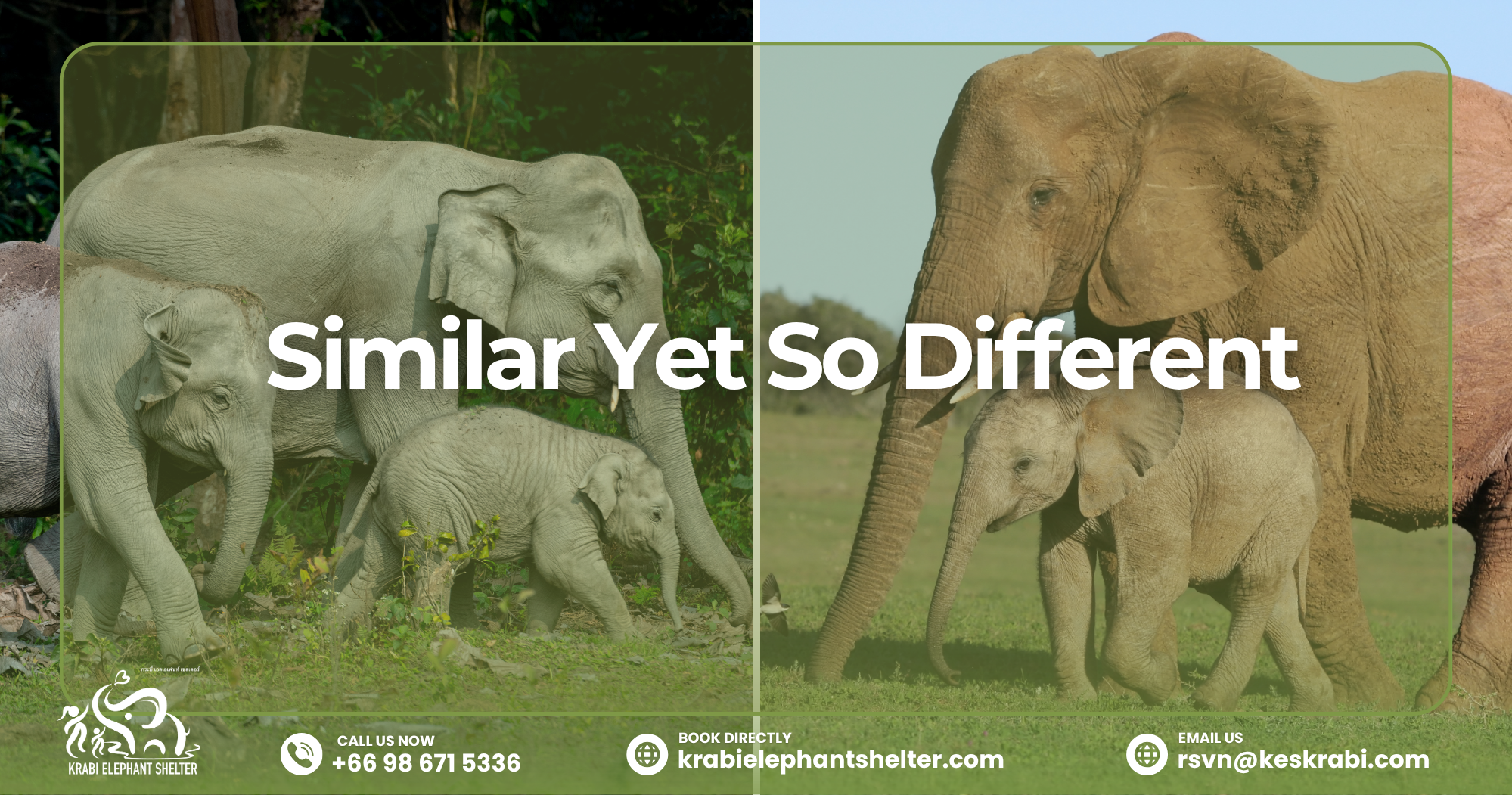When talking about elephants, most people forget that they are not just one species of animal. Instead, Asian elephant vs African elephant differences are both striking and significant. They differ in physical appearance and genetics—more than lions vs. tigers or polar bears vs. grizzlies. In fact, African and Asian elephants even belong to entirely different genera.
What many don’t realize is that there are actually three distinct species of elephants. These include Asian elephants (Elephas maximus), African bush or savannah elephants (Loxodonta africana), and African forest elephants (Loxodonta cyclotis). The latter two are separate species, not merely subspecies of African elephants, even though they belong to the same genus.
Still, the differences between the African savannah and the African forest are not that major, and the two Loxodonta species can even procreate with each other and produce fertile hybrid offspring.
However, the Asian elephant vs African elephant differences are much more significant. So, let’s examine just how these two types of gentle giants differ from one another below.
Physical Differences Between Asian And African Elephants

At first glance, Asian and African elephants don’t differ too much physically, especially for animals that differ so much genetically that they don’t even belong to the same genus. If you know what to look for, however, you can spot quite a few differences that make it pretty easy to tell them apart.
Ears
The big difference you’ll hear mentioned most often is in the ears. African elephants – especially the savannah species – have large ears that look almost like the shape of the African continent itself (although forest elephants have slightly smaller ears). Asian elephants, on the other hand, have much smaller and more rounded ears.
The reason for this difference is simple – African elephants live in a much hotter climate and need larger ears to help cool themselves down. Asian elephants live in a slightly cooler climate and in much denser forests, so they have evolved with smaller and rounder ears.
Tusks
A common misconception is that both male and female African elephants have tusks, but only male Asian elephants have tusks. The more accurate way to put it, however, would be that while female Asian elephants also typically have tusks, they are so small and short that they are usually hidden under their lips, almost like normal teeth.
In other words, both genders of both types of elephants usually have tusks, but Asian elephants have shorter and straighter tusks, so only those of males are usually visible. The reason why Asian elephants have shorter tusks is that they live in denser forests, and long, curvy tusks would be a detriment for them, as they would impede their movement.
Shape Of The Head
Another major difference is the shape of the head. The top of an African elephant’s skull is rounded, like a single dome. On the other hand, Asian elephants have two-domed skulls with a visible lowering between the two humps of the head.
Toenails
Yes, you can easily tell the difference between an Asian elephant and an African elephant if you just count their toenails. Asian elephants have five toenails on their front feet and four on their hind feet. Both species of African elephants, on the other hand, have four toenails on their front feet and three on their back feet.
Skin Texture
While the skin color of both Asian and African elephants is generally the same, there are major differences in texture, mostly because of the different climate both animals live. In general, African elephants have a more coarse skin, whereas Asian elephants are much smoother to the touch.
Additionally, Asian elephants often have freckles on their faces, ears, and trunks. These small spots of depigmentation likely don’t serve any evolutionary purpose, but are just the result of genetics, habitat, and nutrition.
Size
In terms of size, the African savannah elephant is definitely larger than both its African forest brethren and its Asian cousins. If you even see both animals side by side, you’ll easily be able to tell the difference, but here are some numbers too:
- African savannah elephants can weigh between 10,000 and 13,500 pounds (or 4,500 to 6,000 kg), with some males weighing up to 24,000 pounds or 11,000 kg. They are usually 10 to 11 feet tall (3 to 3.4 meters).
- African forest elephants can weigh between 4,000 and 12,000 pounds (or 1,800 and 5,400 kg). They are usually 8 to 10 feet tall (2.4 to 3 meters).
- Asian elephants can weigh between 6,000 and 11,000 pounds (or 2,700 to 5,000 kg). They are usually 6 to 10 feet tall (1.8 to 3 meters).
Of course, all of the above are just averages, and they are often animals of each species that grow to be quite a bit larger. But, on average, African savannah elephants are the largest type of elephant.
Back
Similar to the difference in head shape, there is a small but noticeable difference in the back shape. African elephants have a concave back that dips a bit in the middle, whereas Asian elephants have more rounded backs.
Trunk
Lastly, African elephants famously have two triangular protrusions coming out of the upper and lower ends of their trunks. These protrusions effectively function like opposing “fingers,” and African elephants often pick up things with them.
Asian elephants, on the other hand, have only one such “finger” on their trunks, which is why they usually prefer to grasp objects by curling their trunks around them instead.
African elephants are also believed to have “more sensitive” trunks because they have more whiskers on them than their Asian counterparts.
Asian Elephant Vs African Elephant – Physical Differences
Most of the physical differences above are caused by differences in the habitats in which Asian and African elephants have evolved. Here are the two main differences to note:
Climate
African elephants live in a much hotter and drier climate, hence their larger ears and different skin texture. As a result, they also typically have to migrate more between water sources, whereas Asian elephants migrate mostly between different food sources.
Diet
Both Asian and African elephants are herbivores and eat tree bark, leaves, grass, stems, and roots. African elephants, however, eat much fruit and seeds, and like to break off tree saplings and eat the leaves off them.
Asian elephants, on the other hand, eat more grasses, palm leaves, and bamboo, as well as some farmed crops like bananas and sugarcane.
Asian Elephant Vs African Elephant – Behavioral Differences
If you spend a bit of time around both types of elephants, you may soon start to notice some behavioral differences as well:
Social Structure
Both Asian and African elephants live in matriarch-led herds that expel male elephants once they reach sexual maturity. The difference, however, is that African herds are usually led by a single matriarch and her offspring or by a group of closely related females with a strict hierarchy between them.
Asian elephant herds, on the other hand, live in much more loosely connected groups of up to 15 females and their combined offspring, often without a very strict hierarchy between them. Such herds can also often separate and then reunite.
Bachelor Male Herds
African male elephants often (but not always) form small “bachelor herds” that roam together. Asian male elephants very rarely do this, and usually roam the forests of Asia alone.
Intelligence
Both African and Asian elephants are considered to be extremely intelligent, and “intelligence tests” have a hard time showing which of the two is more intelligent.
However, Asian elephants do have an even greater volume of cerebral cortex, putting them ahead of their African cousins and all other land mammals.
Sociability
Asian elephants are known to be gentler and more passive than African elephants. The latter tend to be more playful and hyperactive, and – when they are grouped together – Asian elephants often interpret that playfulness as “aggression.”
Whether that gentler side of Asian elephants is the reason they were domesticated (and African elephants weren’t) or their domestication is the reason they are now gentler is difficult to say.
Similar Yet So Different
As you can see, telling African and Asian elephants apart is quite easy, both through their physical differences and their behavior. Their significantly different environment is the obvious reason for these differences, though it is still surprising that the two types of elephant are so much alike, given how genetically different they are.
If you want to observe these gentle giants up close and see just how truly intelligent they are, you can book a visit in advance or just join a walk-in tour when you come.
By visiting Krabi Elephant Shelter, your entrance fee directly supports the elephants’ care, including their food, medical treatment, and habitat upkeep. It’s a meaningful way to make your trip count—contributing to long-term animal protection efforts while enjoying a once-in-a-lifetime encounter with Thailand’s most beloved giants.
Book your trip to Krabi Elephant Shelter now!
Phone: (+66) 98 671 5336
Email: [email protected]
Book directly at krabielephantshelter.com`




